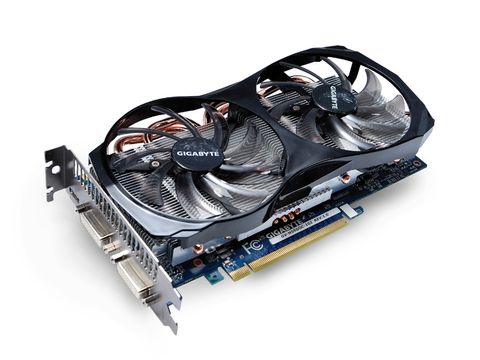TechRadar Verdict
Pros
- +
Price
- +
Cooler design
- +
Overclocking headroom
Cons
- -
Conservative factory overclocking
Why you can trust TechRadar
Discrete graphics processor manufactures AMD and Nvidia are past masters at prising graphic cards into market segments that you or I would think are pretty well packed already – or didn't even realise existed in the first place. But to be fair you can hardly blame them, as shifting prices in the market often have them scurrying to drop the prices of cards or bring out new spins or cores to fill the gap.
Earlier this year Nvidia, and Gigabyte, brought us the GTX 560 Ti, with a stream processor count of 384, to cover AMD's products in the lucrative £200 market segment.
Now we have the GTX 560 (without that Ti tag – maybe it's us, but we're finding the simple dropping of 'Ti' a touch confusing). It slots in between the Ti version and last year's GTX 460 – which is one of the best Fermi cards Nvidia has so far produced – and has the same stream processor count (336) as that venerable 460.
As you might glean from Gigabyte's GV-56OC-1GI model name it comes factory overclocked out of the box and, as well as the tweaks on the clock speeds, it also has the latest Gigabyte designed cooling and top notch components in the power circuitry to make sure everything remains cool and stable.
So what exactly does that mean with regards to pixel-pushing power? Well, factory overclocked it may be but the amount of tweaking that's been done is pretty minimal to say the least – just 20MHz over the stock speed of 810MHz for the core and 40MHz on the shader engine to give 1,660MHz. Meanwhile, the memory clock is left untouched at 1,002MHz (4GHz effective).
Restrained approach
Just how conservative these settings are is put sharply into focus when it's compared to Zotac's AMP! version, which comes with a massively overclocked 950MHz core clock and memory running at 1.1GHz (4.4GHz effective).
That conservatism is also highlighted by the small amount of overclocking we've tried in the labs. Our review sample ran stably with a core clock at 912MHz, shader clock at 1,824MHz and a memory clock of 1,077MHz (4.3GHz).

Benchmarks
DX11 tessellation performance (1080p)
Heaven 2.5: Frames per second: Higher is better
Nvidia GTX 560 Ti: 26.5
Zotac GeForce GTX 560 AMP!: 24.8
MSI N560GTX Twin Frozr II: 22.8
Gigabyte GV-56-OC-1GI: 21.6
Nvidia GTX 460: 17.4
DX11 gaming performance (1080p)
AvP: Frames per second: Higher is better
Nvidia GTX 560 Ti: 37.2
Zotac GeForce GTX 560 AMP!: 34.5
MSI N560GTX Twin Frozr II: 31.7
Gigabyte GV-56-OC-1GI: 27.7
Nvidia GTX 460: 24.7
The new design of cooler and heatsink, which Gigabyte has named Windforce, works very well and kept the card cool and stayed quiet while doing so. But then so it should with a whopping great pair of 100mm PWM fans taking the heat away from the four (6mm) heat-piped heatsink.
Gigabyte's GTX 560 OC is yet another first rate Fermi board, which may end up being as popular as the GTX 460, especially given its headroom when it comes to overclocking and its price tag. That said, of all the latest GTX 560s we've tested this one came behind the rest, failing to even hit the Zotac card's out-of-the-box settings.
Gigabyte's new design of cooler, however, is very good, ably chilling the GPU remaining quiet even when the card is stressed while overclocking. It's just a shame that it didn't bite the bullet and turn up the clock speeds just a little bit more, especially given the presence of the new Windforce cooler.
Follow TechRadar Reviews on Twitter: http://twitter.com/techradarreview

